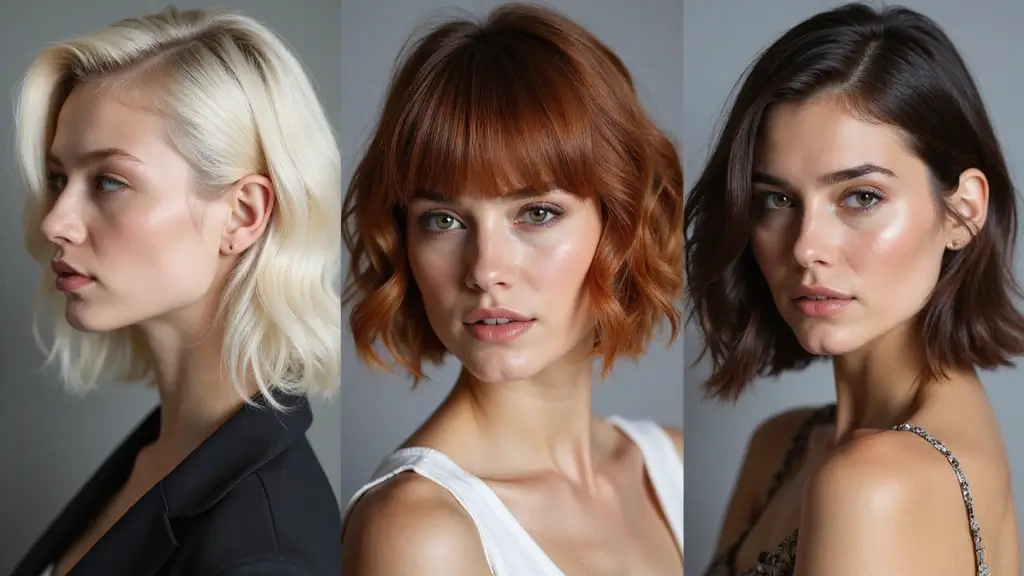If you want a cut that turns heads but still feels like you, the inverted bob might be your next go to. Today I’m walking you through 28 inverted bob haircut styles that turn heads everywhere. You’ll see a range from sharp angles at the back to a longer front that frames the face. These looks work with straight, wavy, or curly hair and you can wear them sleek for work or messy for weekends. Tiny tweaks change the vibe, from bold to soft and wearable.
Why I made this post Style trends move fast. The inverted bob keeps showing up in real life and on feeds. I want to give you a clear guide with real looks you can copy.
Who it’s for If you love bold cuts but want something easy to maintain, this is for you. If you juggle work, family, and social life and need a haircut that looks good with little effort, this will help. This post is for anyone who wants a chic hairstyle that travels well.
What you’ll get Here you get 28 ideas that cover a range of textures and lengths. Each style comes with a quick note on who it fits best and how to style it. You will find tips on tools and products and upkeep.
If you wonder how to choose, here are some practical checks. Will a short back suit a round face? How long should the front be to keep balance? How do you keep the shape as it grows out? I keep the answers simple and direct so you can apply them right away.
Next steps keep it easy. Save a few photos that show the look you want. Talk to your stylist about a trial cut. Plan a follow up in a few weeks to tweak the line if needed. With the right inverted bob haircut style, you can turn heads wherever you go.
1. Sleek Asymmetrical Bob
If you want a bold yet easy hairstyle, the Sleek Asymmetrical Bob fits. It uses a longer side to create a sharp angle that frames your jawline. For fine hair, it adds the look of thickness without weighing you down.
– What it is: One side stays longer than the other. This angle makes your face look sculpted and your neck look longer.
– Styling Tips: Use a flat iron for a sleek finish. Apply a light serum to tame flyaways. Dry with a round brush to add lift on the shorter side.
– Occasions: Formal events or a day at the office. Dress it up with a stylish clip or keep it plainer for a clean, chic look.
– Maintenance: Schedule trims every 6 to 8 weeks to keep the lines sharp. Choose a color-safe shampoo to keep shine. Condition the ends to prevent frizz.
– Color Ideas: Balayage adds depth by blending darker roots with lighter ends. A soft ombre can make the cut pop.
– Who it suits: Best for fine to medium hair. It works with straight, wavy, or lightly curled styles.
– Next steps: Pin a photo to your stylist. Ask for a quick mock-up at your next appointment. Consider a subtle color test to see the effect in lighting.
This cut grows out well and still looks stylish as you wait for your next trim.
2. Layered Inverted Bob
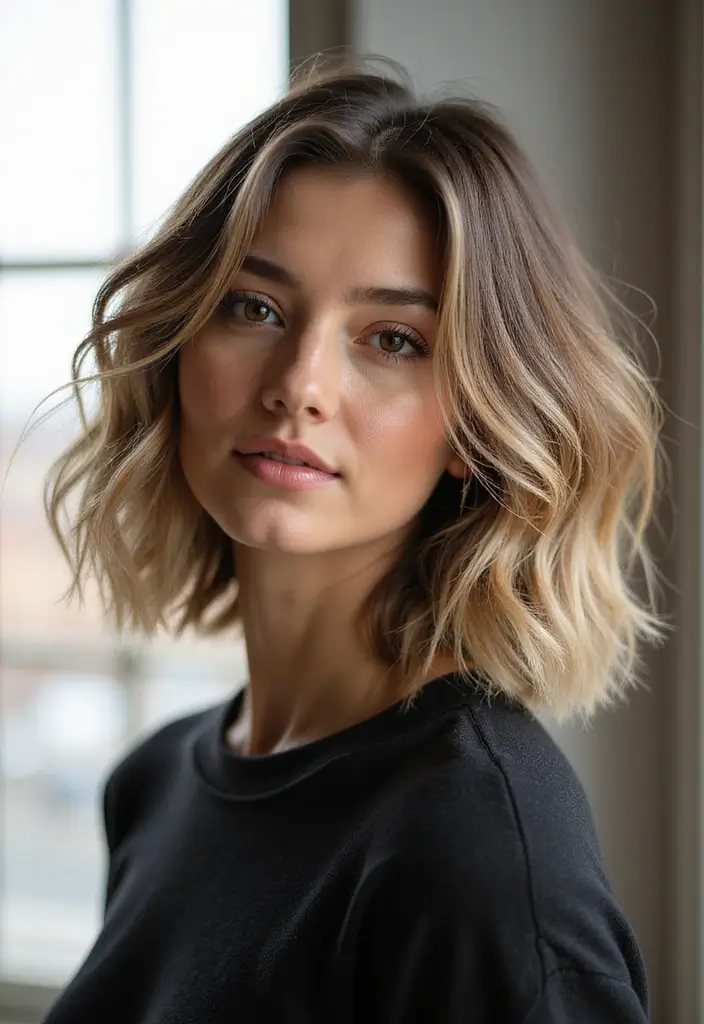
You want more texture and lift without losing the chin silhouette. A layered inverted bob gives you that. Layers add movement and bounce, especially on fine hair. They create a fuller look while keeping the shape sharp. The shorter back and longer front frame your features, drawing attention to your eyes and smile.
– What it does: Layers add depth and keep body.
– How to style: Start with damp hair. Apply a volumizing mousse at the roots. Blow-dry with a round brush, lifting the crown. Let the ends flick for natural movement.
– Occasions: Great for casual weekends or a smart dinner out.
– Maintenance: Trim every 6–8 weeks to keep the line tidy. Use light product for flexibility.
– Color ideas: Highlights or balayage on the layers catch light.
This cut stays playful while looking polished. It suits many face shapes and works well with straight or wavy textures. If your hair is very fine, start with a softer layer length and build from there. Remember: layering takes a bit more care, but the payoff is real. Next steps: ask your stylist to tune the layer length to frame your face. Give it a try and see how it moves.
3. Textured Waves Inverted Bob
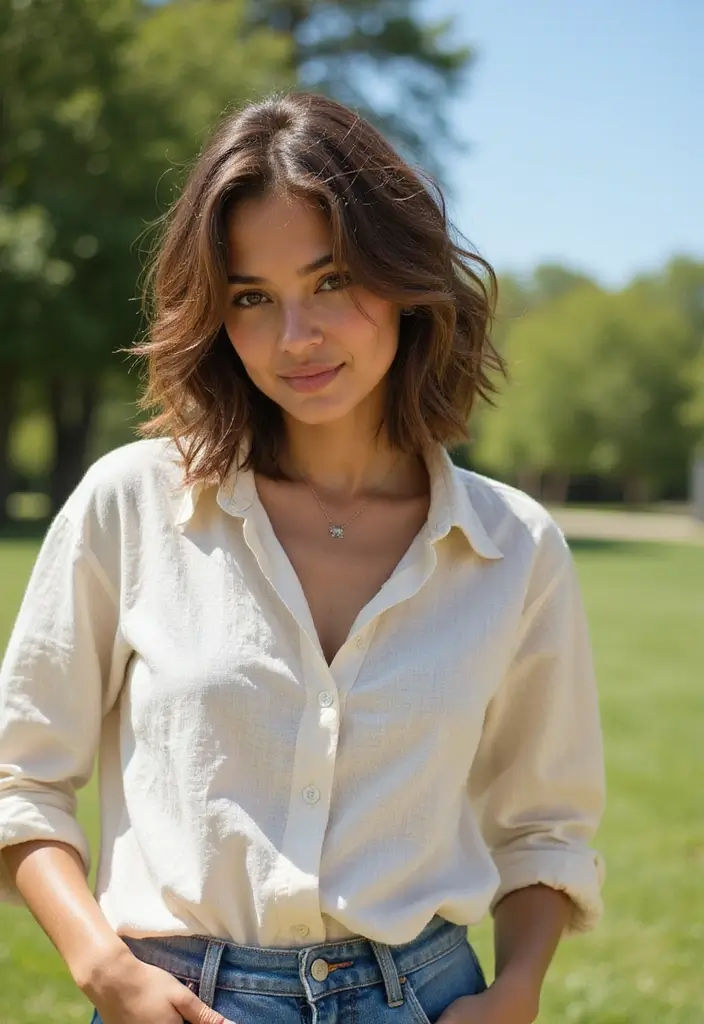
You want a chic inverted bob that still feels easy. Textured waves give that look. They add lift at the roots and soften the line of the cut. You can make them with a curling wand or by braiding damp hair overnight. The result? A relaxed, beachy vibe that still looks put together.
What you’ll need
– Sea salt spray or a texturizing spray for grip.
– A heat protectant to shield your ends.
– A curling wand about 1 inch in diameter.
– A comb or brush for quick touch-ups.
– Optional: a light hairspray for hold.
Next steps. Here is how to build the waves.
Step-by-step guide
– Step 1: Start with dry hair and a thin veil of heat protection.
– Step 2: Curl small sections, wrapping away from and toward your face for a natural mix.
– Step 3: Let curls cool, then gently finger-comb them loose.
– Step 4: Mist with sea salt spray and scrunch for texture and movement.
Finish and care
– Use a light hold spray to keep the look without stiffness.
Color idea: an ombré transition adds depth without shouting color.
Maintenance: trim every few months to keep the shape fresh.
This style invites a carefree spirit while staying simple to master.
4. Messy Bob with Bangs
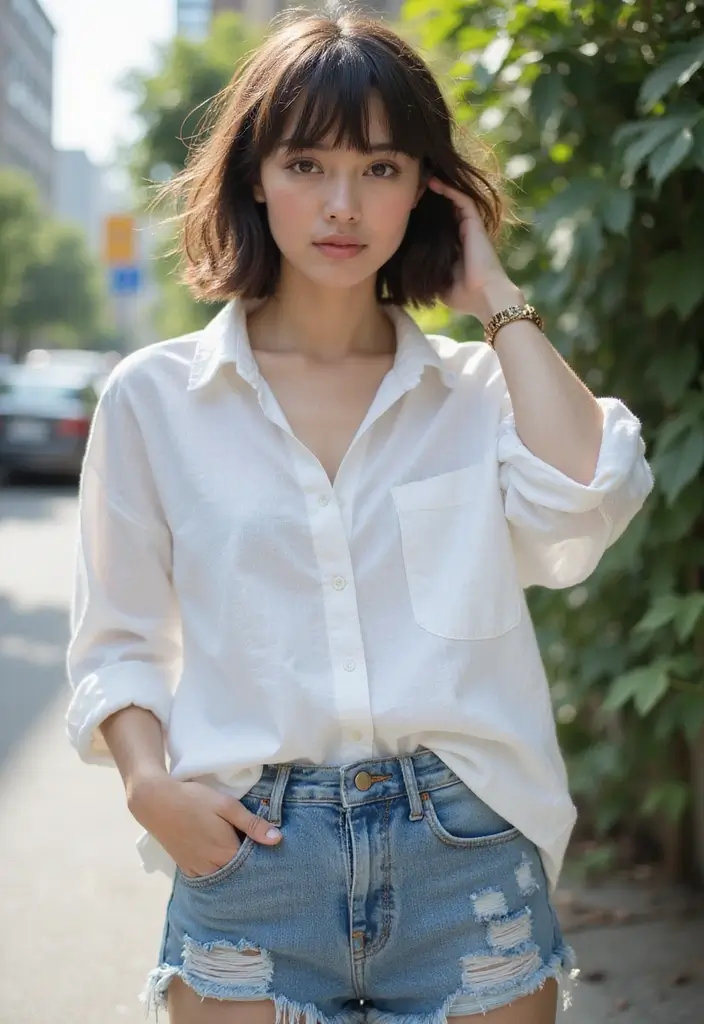
You’re after a look that’s easy to wear and still turns heads. The messy bob with bangs gives you that just-rolled-out-of-bed vibe with a chic edge. It suits fine hair, because it adds texture and movement without weighing you down. The bangs frame your eyes and soften your features, so you look fresh and inviting.
– Styling tip: Start with damp hair. Apply a texturizing spray from roots to ends. Scrunch with your fingers and tilt your head as you dry. A quick blast with a diffuser adds a natural bend.
– Occasions: Perfect for casual hangouts, coffee dates, or a quick errand run. You can dress it up with a bright lip or simple earrings for a night out.
– Maintenance: Bangs need trims every 4 to 6 weeks. The rest of the cut stays low maintenance—wash, quick dry, and go.
– Color ideas: Try a pastel streak or soft sun-kissed lowlights for depth.
Here is why it works: it gives a modern, carefree vibe that still reads polished. Let’s break it down: you can tweak bang length and texture to suit your face. Next steps: test the texture spray, try two partings, and adjust.
5. Classic Inverted Bob
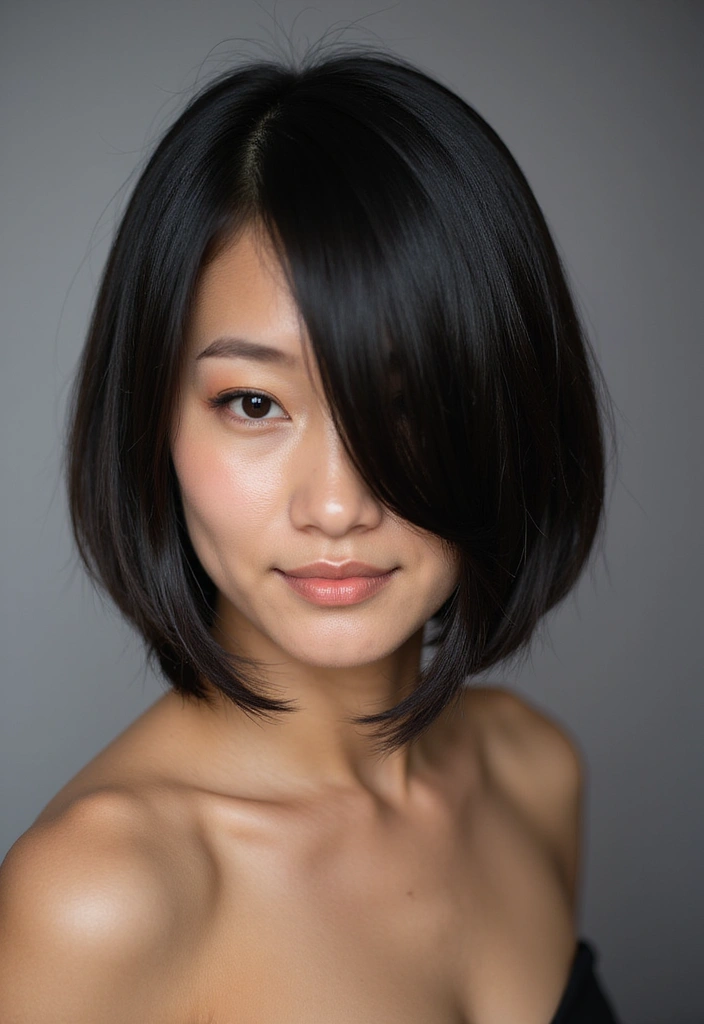
You want a cut that looks sharp from desk to dinner. The classic inverted bob fits the bill. It has a shorter back and longer front strands. This back-to-front shape adds height at the crown and keeps hair easy to style. It reads polished and playful without drama. If you want a low-maintenance cut that still makes a statement, this inverted bob is a smart pick.
– Styling Tip: Use a ceramic straightener for a sleek, polished finish.
– Occasions: Great for business meetings and formal dinners.
– Maintenance: Trim every 6 to 8 weeks to keep the shape clean.
– Color ideas: Soft highlights or a light balayage add depth without changing the feel.
Here is why this cut works. It hugs the jawline softly, which flatters many faces. The shorter back creates a clean silhouette when you move. Longer front strands frame the eyes and soften strong features. The cut works with straight, wavy, or lightly curled hair, so you can style with your usual tools. Let your natural texture shine and keep the look simple.
Next steps: Try a few small changes to tailor the length and color to your face. Visit a stylist for a quick test, then adjust with trims and color at home.
6. Curly Inverted Bob

If you crave a style that fits curly hair and keeps you looking fresh, the curly inverted bob is for you. It puts your natural texture at the center and adds real volume. The back is shorter, which makes shaping easy. The front stays longer and playful, so you still get that flirty swing.
Here is why it works for curls. The shorter back reduces bulk at the nape and helps every curl spring to life. You get lift from the crown, so your hair looks full even on days you skip flat ironing. It’s a low fuss look that travels well from casual days to big nights.
– Styling tip: Work a curl-enhancing cream through damp hair. Scrunch gently from tips to roots. Let it air dry or use a diffuser on low heat for soft ringlets.
– Occasions: Great for everyday wear, work days, or a night out. Your curls stay defined and easy to manage.
– Maintenance: Keep curls hydrated with a weekly deep conditioner. Use a gentle shampoo and trim the ends every 6–8 weeks to maintain shape.
– Color ideas: Rich chestnut or warm caramel can boost curl bounce and add depth to your look.
Next steps: start with a trim to your natural curl pattern, then test a light cream to define texture. If you want more volume, flip your head over while drying and lift at the crown. With this cut, your curls shine with simple care and real comfort.
7. Blunt Cut Inverted Bob

You’re after a look that feels sharp and confident. The blunt cut inverted bob fits that need. It creates a clean end line that frames your face and makes your cheekbones pop. For fine hair, it adds the look of density without weighing you down. It’s easy to wear and stays chic from day to night. Here is why it works.
With an inverted bob, the back sits a touch shorter than the front. The tilt gives lift at the crown. Blunt ends keep the line bold, so the style reads strong, not wispy. It moves with you and works with many outfits.
– Styling tip: Use a light hairspray to lock the ends without stiffness. Dry with a round brush to push the front pieces under for a crisp frame.
– Occasions: Fashion events, gallery openings, or a work day when you want edge that stands out.
– Maintenance: Trim every 4 to 6 weeks to keep the blunt line sharp and the inverted shape clean.
– Color ideas: Balayage adds depth, or go solid with a deep brown or black for drama.
If you want a look that shouts confidence, the blunt cut inverted bob is for you. Next steps: consider a quick at home blowout test or book a salon appointment to see it in person.
8. Ombre Inverted Bob
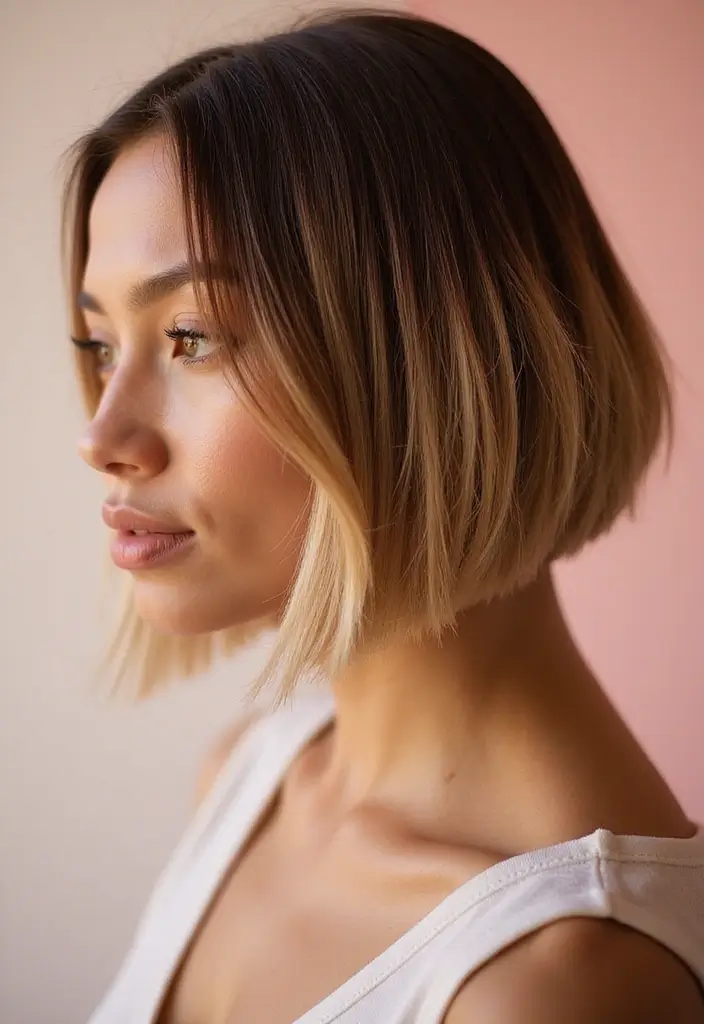
Looking for a haircut that turns heads but stays easy to wear? The ombre inverted bob fits. It keeps the sharp shape of the inverted cut and adds a color fade that starts dark at the roots and becomes lighter toward the ends. The look has depth, movement, and a playful touch. Here is why it works for many hair types.
– Styling tips: Use a curling wand on medium heat to add loose waves. Scrunch in a texturizing spray for grip. Let the waves cool, then finger comb to keep the shape clean.
– Occasions: Perfect for festivals, casual lunches, and date nights. It reads stylish without trying too hard.
– Maintenance: Color fades with time, so plan color touchups every 6 to 8 weeks. Use a color‑safe shampoo and cool water to slow fading. If ends look brass, a gentle toner helps keep the fade smooth.
– Color ideas:
– Espresso roots to caramel ends for a warm, natural glow.
– Deep burgundy roots to coppery blonde ends for bold contrast.
– Ash brown roots to pale gold ends for a cool, modern vibe.
Blend three tones where the shift feels seamless rather than harsh.
This style blends fun with polish. With the right care, your ombre inverted bob stays fresh and eye-catching.
9. Shaggy Inverted Bob
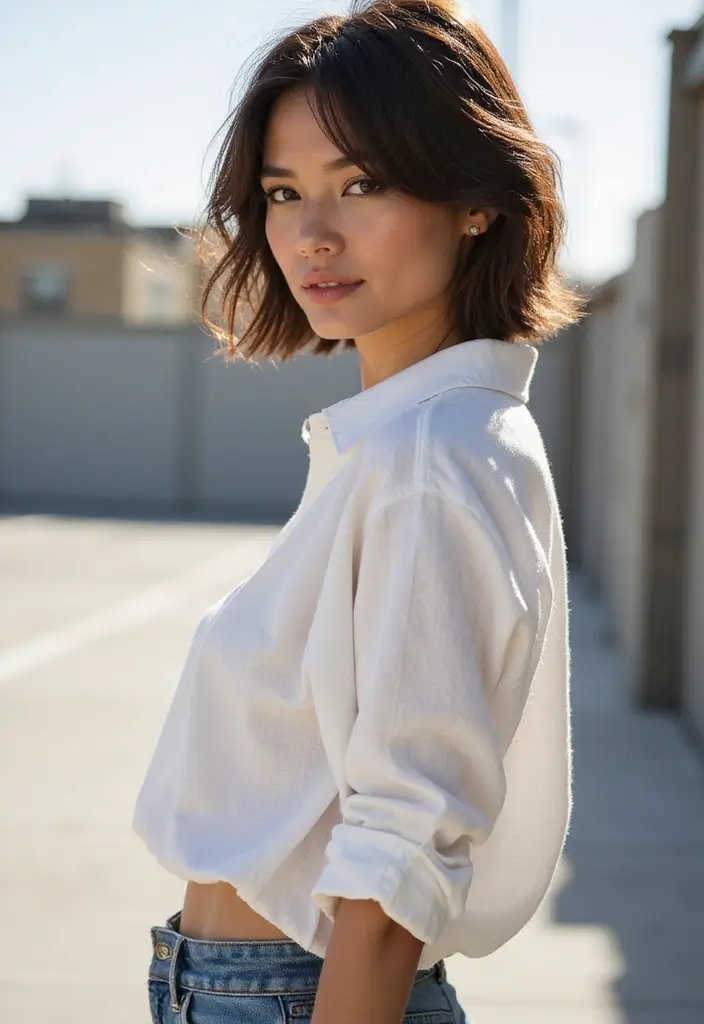
You want a cut that feels easy to wear but still makes an impression. The shaggy inverted bob gives texture and movement with a short back that stays clean. It works best if you have fine hair, because the layers boost volume without adding bulk. You get a modern, lived-in look that doesn’t need a lot of styling. It adapts to many face shapes and stays easy to wear.
– What it is: A stacked back with rough, choppy layers on top and at the sides.
– Why it works for fine hair: Layers add volume and movement without making hair look heavy.
– Styling tip: Apply a light mousse to damp hair and scrunch as you dry.
– Occasions: It suits casual days, shopping trips, and relaxed gatherings.
– Maintenance: Low maintenance means a quick trim every six to eight weeks.
– Color ideas: Balayage or soft highlights on top brighten texture and add depth.
– Final look: This cut feels carefree and youthful, with movement you can see.
Try this look with a soft wave. Use a texturizing spray for extra grit. Keep the ends lighter to keep the camera-ready shine. If you want a bolder look, ask for stronger texture at the crown. Or skip the color and keep a natural shade that shows off the cuts.
10. Edgy Undercut Inverted Bob
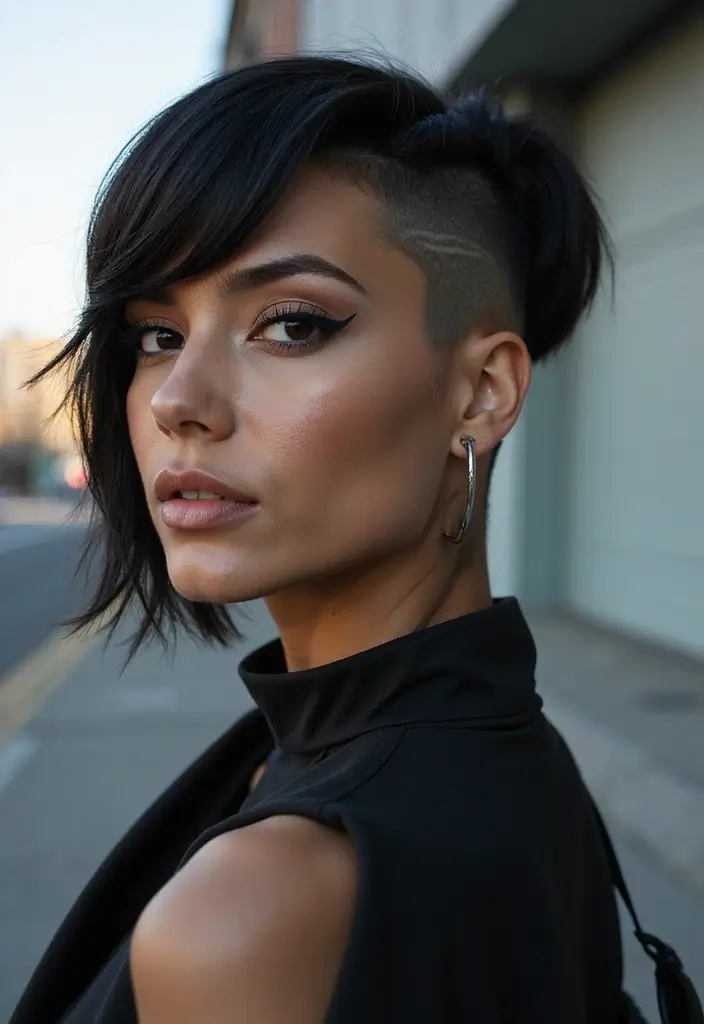
Here is why the edgy undercut inverted bob works for you. You get a clean contrast: shaved sides or back with a longer top. It reads as modern and fearless, yet it’s easy to style.
– Styling tip: Keep the long crown smooth with a light smoothing serum. A small amount of shine helps the top pop. If you want texture, run a touch of matte paste through the ends.
– Occasions: This cut shines at parties, concerts, and nights out. It also works on casual days when you lift the top for a soft bounce.
– Maintenance: Schedule trims every 3 to 6 weeks to keep the sides sharp. The top is easy to refresh with a quick blow-dry or a gentle straightening pass.
– Color ideas: Bright hues grab attention. Try neon pink, electric blue, or lavender. Pastels look softer on the top while the undercut stays bold. Use color-safe shampoo to keep shades fresh.
This inverted bob with an undercut lets you express your style without extra fuss. Next steps: bring a few photo ideas, talk to your stylist about how short the sides should be, and choose color swatches.
11. Vintage-Inspired Inverted Bob

Want a cut that adds lift without losing classic charm? A vintage-inspired inverted bob fits the bill. It mixes old-time glamour with clean, modern lines. The back stacks up and the front angles down, so your face stays framed and polished. It works well on fine hair by creating natural volume and movement. It also works as a daily look that still shines in photos.
– Styling Tip: Use hot rollers for soft, elegant curls.
– Occasions: Perfect for weddings or vintage-themed events.
– Maintenance: Regular trims every 6 to 8 weeks to keep the shape.
– Color Ideas: Soft copper or deep brunette shades boost the retro vibe.
To make the look last, start with a light mousse on towel-dried hair. Blow-dry with a round brush to lift the crown. If you want more bounce, set the ends under with hot rollers and let them cool. Finish with a flexible spray that keeps the style without stiffness. Copper shades catch light in photos, while deep brunette adds a dramatic, old-school mood. Keep in mind that this cut fits many face shapes, but length can feel shorter as hair grows out. If you want a bolder finish, tease the crown a touch and brush the ends for a soft, windswept fall.
12. High-Volume Inverted Bob

If you want more lift, a high-volume inverted bob can deliver. It adds layers and height, making hair look thicker. The inverted shape keeps things playful while still feeling polished.
– How it works: The shorter back and longer front create a clear inverted silhouette. Layered crown pieces boost root lift for instant volume.
– Styling steps:
1) Start with a lightweight volumizing spray on damp hair.
2) Blow-dry using a round brush, lifting at the crown.
3) Pinch small sections while drying to set the shape.
4) Finish with a light mist of setting spray to hold the height.
– Occasions: It shines at parties and nights out. It also reads bold on everyday days when you want a fresh look.
– Maintenance: Get trims every 6 to 8 weeks to keep the shape. Use a gentle brush and avoid heavy products that weigh hair down.
– Color ideas: Try copper or rich chocolate to boost depth. Add a few lighter streaks at the crown to make the top feel even fuller.
Here is why this cut works for you: it’s easy to tailor to your hair texture and face shape. You can push the crown higher or soften the ends for a subtler vibe.
Next steps: pick a styling routine, book a trim, and test a color pop if you want extra impact.
Elevate your style with a high-volume inverted bob! This playful haircut not only adds layers and height but makes fine hair look effortlessly thick and fabulous.
13. Faded Color Inverted Bob

If you want a look that feels fresh but not loud, the faded color inverted bob is for you. It pairs a clean, stacked cut with colors that softly fade along the length. You get edge and elegance in one style.
– What it is The faded color inverted bob blends soft shades with a sharp cut. The colors fade across the hair for a smooth look.
– How to style Start with clean base color. Ask for a seamless color fade from root to ends. Use a color-safe gloss to keep the transition shiny.
– Color ideas Try blush pink with a warm base. Pastel blue works well on cool tones. You can mix tones at the crown for depth.
– Occasions It suits art events, casual meetings, and photoshoots. It looks polished without shouting.
– Maintenance Expect regular salon visits every 6 to 10 weeks. Between visits, use color-safe shampoo and a brightening conditioner.
– Practical tips Protect hair with heat spray before styling. Detangle with a wide-tooth comb. Dry with a diffuser for even color.
– Quick tip If you want more shine, add a light serum after styling.
– Next steps Bring a few color ideas to your stylist and test a soft fade first.
This look is versatile and easy to adapt as you grow with the cut. Try it this week.
14. Side-Swept Inverted Bob
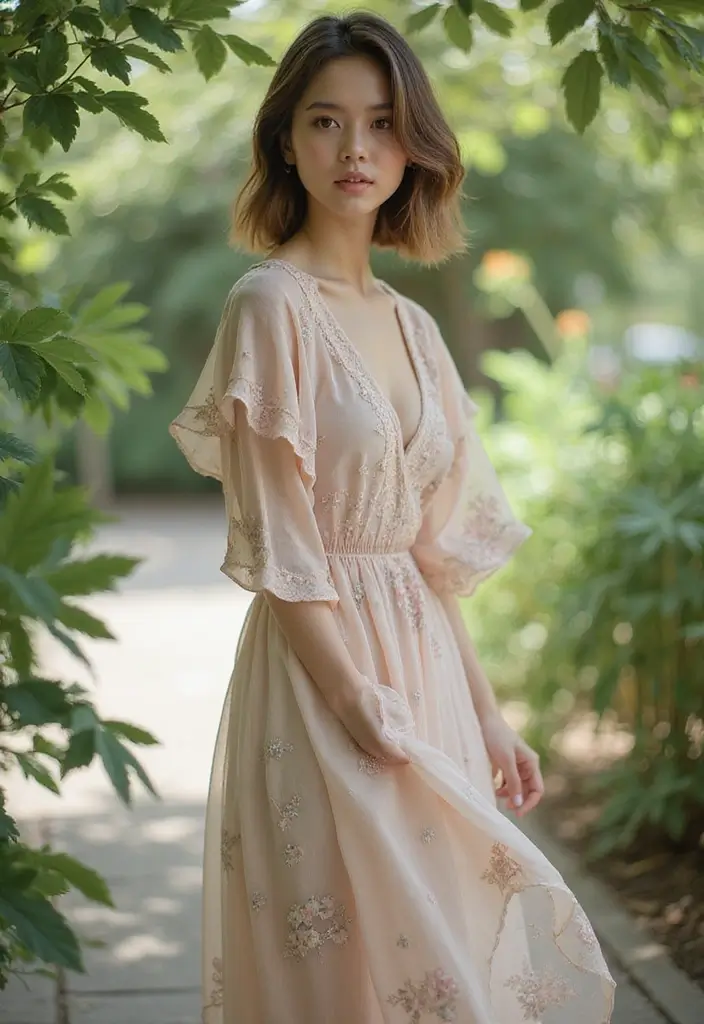
Here is a look you can wear on many days. You want something that feels fresh but not fussy. The side-swept inverted bob fits that need. It uses longer front pieces that swing to one side. The result is a soft frame for your face with a touch of romance. You can tweak the front length to fit your hair and face.
Here is why it works:
– What it is: A chin-length bob with a longer front that sweeps to one side.
– The shape adds movement and softens lines.
– It suits many hair types and face shapes when you keep the length balanced.
Next steps: how to style
– Start with clean hair. Use a light mousse for lift.
– Blow-dry with a round brush, guiding the front section to the favored side.
– Finish with a light spray to hold the sweep without stiffness.
Maintenance and color
– Trim every 6 to 8 weeks to keep the line neat.
– Choose warm tones like honey or caramel to boost the soft feel.
Occasions and tips
– Great for date nights, work days, and casual weekends.
– If you have a round face, keep the front piece a touch longer to soften angles.
– Fine hair gains body with a touch of texture spray.
– It also works well for professional settings.
This style radiates charm and confidence.
15. Bold Two-Tone Inverted Bob
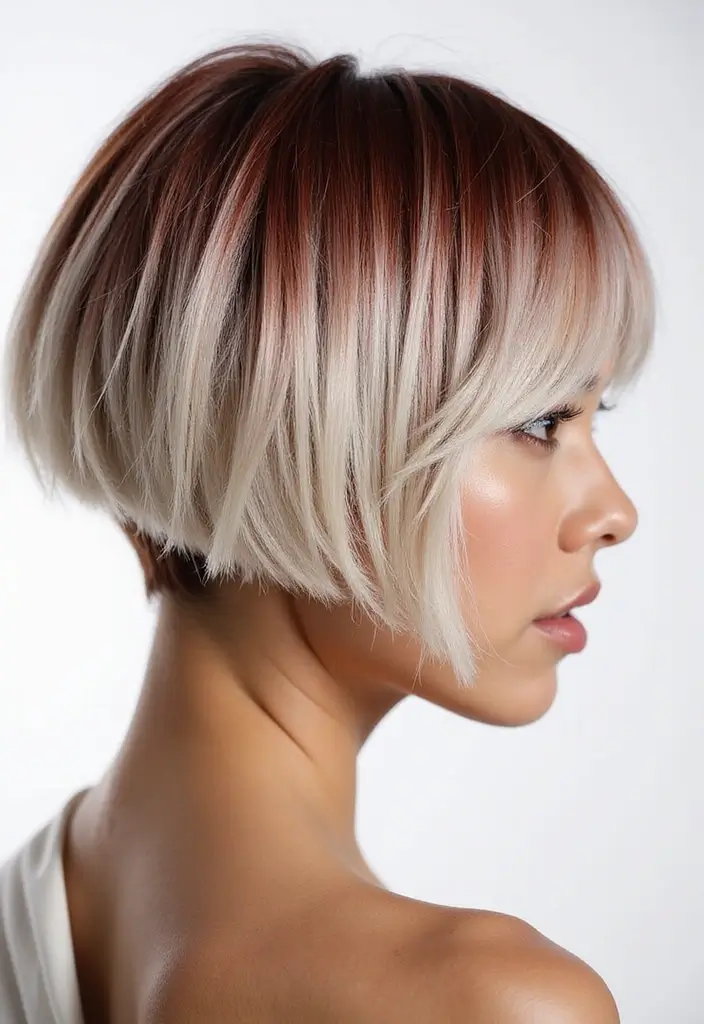
You want a look that stops people in their tracks. The bold two-tone inverted bob does it with ease. It pairs a sharp cut with color that clashes on purpose, so your style feels alive. Here is why this look works.
What you get
– A short back, with longer sides framing your face.
– Quick color that changes with light.
– A modern shape that fits many textures.
Color ideas
– Black and platinum for a high-contrast punch.
– Chestnut with copper for warmth.
– Teal with pale silver for a bold vibe.
Care and upkeep
– Use a color-protecting serum to keep hues bright.
– Wash with a color-safe shampoo to slow fade.
– Plan color touch-ups every 4 to 6 weeks.
Style tips
– Keep roots neat to keep the line clean.
– Apply a shine spray for a glassy finish.
– Use a flat iron in small sections for a sleek look.
Who it fits
– It works for anyone ready for a bold change.
– It suits straight or wavy hair alike.
– It shines when you want a striking statement.
Choosing color pairs
– Start with a dark base that matches your skin tone.
– Add a lighter shade for the second tone to boost contrast.
– Pick colors that fit your lifestyle and upkeep.
Next steps: bring photos that show your two tones to your colorist. You may love this bold vibe.
16. Soft Layered Inverted Bob

Here is why you need a cut that stays light and looks fresh. It adds movement without adding weight. This is the soft layered inverted bob. It works well on fine hair.
What this style gives you
– Lift at the crown with soft layers.
– A short back and longer front for an easy, flattering shape.
Two simple ways to style
– Straight look: Blow-dry with a round brush to lift the roots. Lightly run a small flat iron over the ends for a clean finish.
– Soft waves: Apply a touch of sea salt spray. Scrunch gently and let it air dry or use a diffuser.
Maintenance and color ideas
– Trim every 4 to 6 weeks to keep the shape sharp.
– For color, soft blonde highlights or a hint of caramel add depth without taking over.
Why it works for you
– It gives gentle elegance that goes with many outfits. It stays light on fine hair but still looks full and polished.
Next steps.
– Bring photos of a soft layered inverted bob to your next haircut. Explain you want the shorter back and longer front with gentle layers. You may love the bounce and daily ease.
17. Hipster Inverted Bob
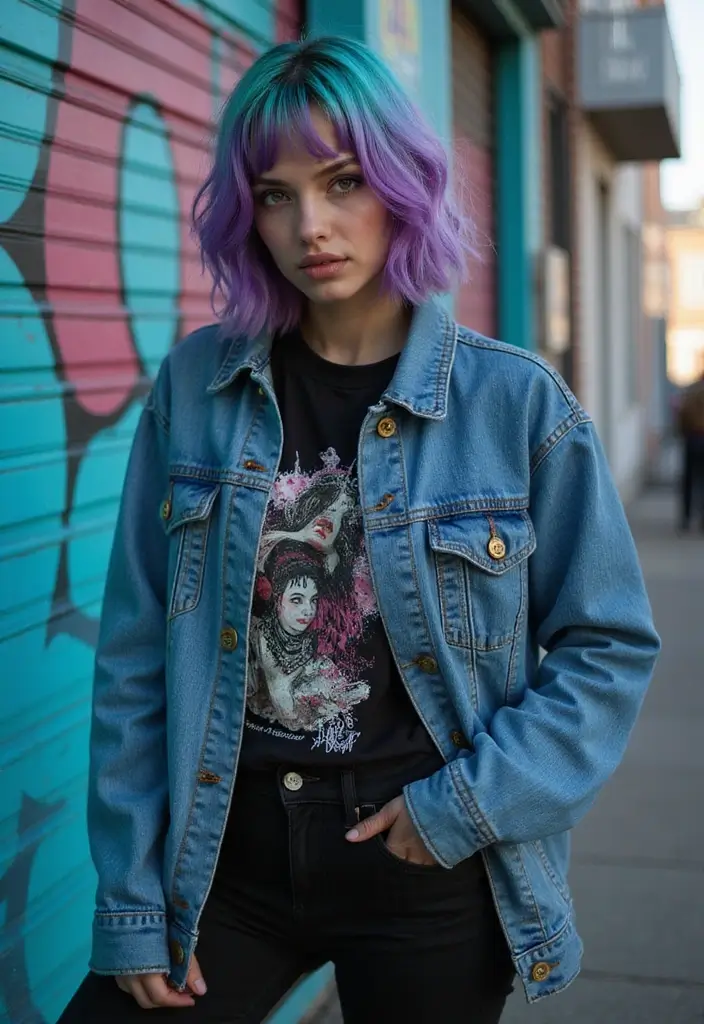
Are you looking for a cut that shows your creative side but still stays easy to wear? The hipster inverted bob is a smart pick. It keeps things chic while letting your personality shine. The shape is short in the back and longer toward the face, with a strong curve that reads artsy.
What it is
The look blends a classic bob with an edgy twist. It gives you clean lines and room to play with color and texture. You control the drama: keep it sleek or go bold with styles that stand out.
How to style
– Try hair chalks or temporary colors for a quick, standout effect.
– Add texture with a sea-salt spray for a matte, lived-in feel.
– Blow-dry with a round brush to curve the ends under and keep the inverted shape.
Where it works
– Festivals, art shows, or casual meetups are all good fits. It also suits someone who loves a bold, easy-to-change look.
Maintenance
– Trim every 6 to 8 weeks to keep the line sharp.
– Use color-safe shampoo and a heat protectant.
– Refresh color as needed with small touch-ups at the roots.
Color ideas
– Neon pink, electric blue, or teal for a bright statement.
– Pastels like lavender or mint for a softer vibe.
– Rainbow streaks or bold color blocks for maximum contrast.
Hipster inverted bob blends art with ease, giving you a look you can own.
18. Spring-Inspired Inverted Bob
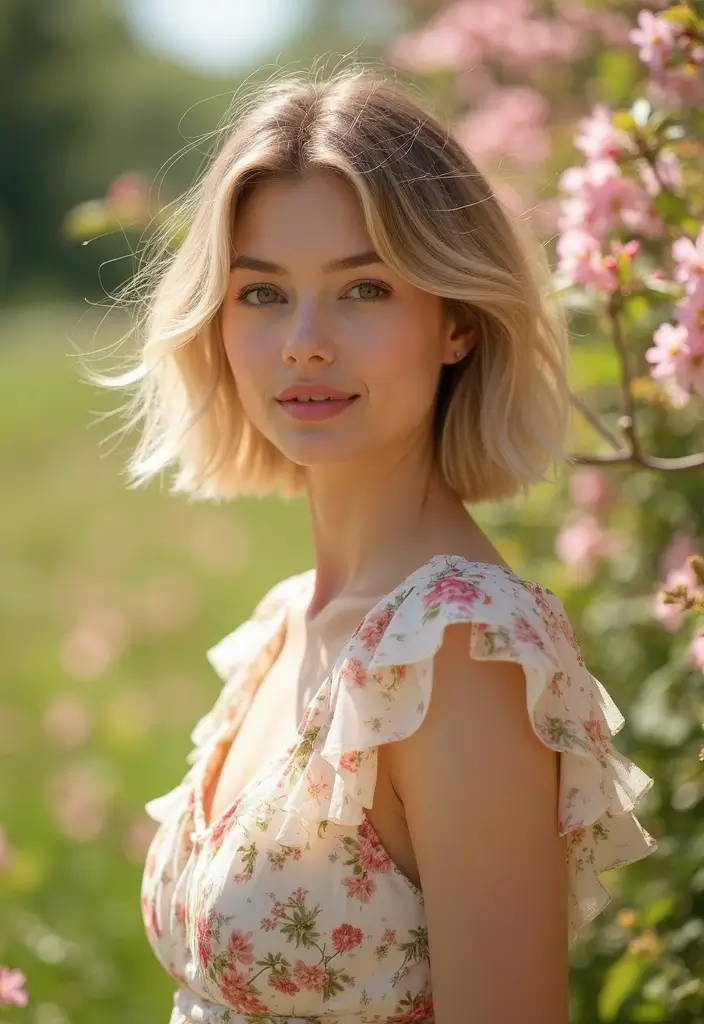
Spring-Inspired Inverted Bob
You want a look that fits warm days. The inverted bob stays light and easy to wear. The back sits a touch shorter, while the front layers frame your face. It catches spring sunshine and keeps you cool. It’s simple, stylish, and quick to style.
Here is why it fits spring:
– Styling tips: Start with a light hold cream. Dry with a round brush to lift the crown. Let the ends bend under for a soft, natural frame.
– Occasions: Great for outdoor events, picnics, and casual days in the sun.
– Maintenance: Trim every 6 to 8 weeks to keep the shape clean.
– Color ideas: Soft pastels or sun-kissed tones look best. Try pale peach or creamy blonde with subtle highlights.
This cut gives you a clean, confident vibe for spring.
Next steps: Try a simple home routine. Gather a mirror, a round brush, and a light product. 5-step styling:
1) Wash and towel dry.
2) Apply a light product.
3) Dry with the brush, lifting the crown.
4) Shape the front pieces with your fingers.
5) Finish with a light mist.
If you want more lift, ask your stylist for a gentle crown boost. A glossy finish helps pastel colors stay bright.
With the right cut and color, spring becomes easy to wear.
19. Elegant Updo with Inverted Bob

If you want a look that’s polished without being fussy, an elegant updo with an inverted bob could be your go-to. It blends the sharp line of an inverted bob with the grace of an updo. You get a clean silhouette and a hint of drama at the nape.
Here is why it fits real life. It stays secure through long events. It flatters many face shapes. It gives you a high-fashion vibe without pinning you to the mirrors all night. This combo works well for weddings, galas, or any formal gathering.
How to recreate it at home. Here is a simple path you can follow:
– Start with smooth, brushed hair and a light holding product to tame flyaways.
– Lift the crown slightly and comb the top section back, creating a gentle lift over the inverted bob.
– Pin the sides and the crown into a neat updo. Let the nape show just enough to add neck length and elegance.
– Use bobby pins to secure every part. Finish with a soft mist of lightweight spray.
– Leave a few face-framing strands loose if you like a softer look.
Occasions where it shines. This style pairs well with weddings, formal dinners, and gala nights.
Maintenance and color ideas. Schedule regular trims to keep the bob crisp. Try deep, rich hues like espresso, burgundy, or midnight blue for a formal touch.
Next steps. Practice once or twice before the big day so you know your pins and product work together smoothly. This look stays elegant and sophisticated all night long.
An elegant updo with an inverted bob is your secret weapon for a polished look that lasts all night. Perfect for any formal occasion, it’s the blend of sophistication and style every woman deserves!
20. Elegant Braided Inverted Bob
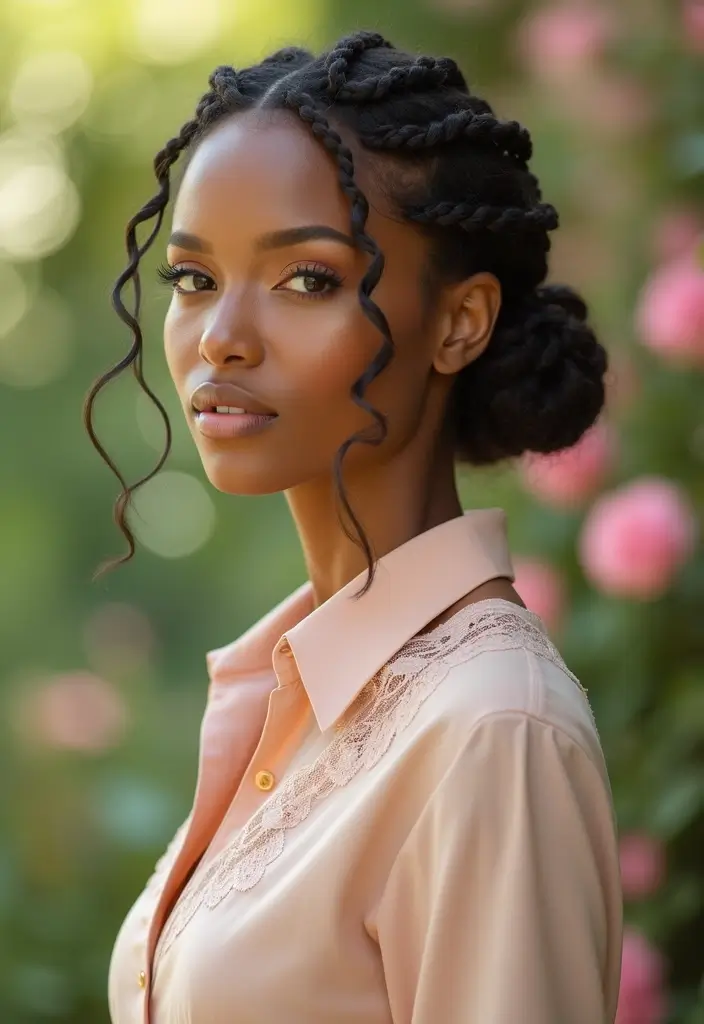
If you want a chic twist on the inverted bob, try the elegant braided version. Braids add a soft, decorative touch while keeping the clean line of your cut. It looks great in photos and stays comfy all day.
What you gain
– Styling: Tiny front braids frame your face with a delicate look.
– Occasions: Perfect for outdoor events, parties, and everyday wear.
– Maintenance: Low effort; keep the braids tight so they hold shape.
– Color ideas: Soft highlights lift the braids and add depth.
How to recreate this look
Here is how to try it at home.
1) Start with clean, dry hair and a simple crown part.
2) Braid two to four thin sections along the hairline, keeping them tight.
3) Bring the braids toward the crown and secure them with small clear elastics.
4) Tuck the ends into the rest of the inverted bob or pin them flat.
5) Finish with a light mist of hairspray and a drop of shine serum.
Care and quick tips
– Gently remove elastics to avoid tugging.
– Use a small amount of lightweight oil for smoothness.
– If your hair is thick, add a couple more mini braids for texture.
Here is why this style works: it blends the classic shape with soft texture, plus it stays comfortable as you move through your day.
Next steps
Try this braided inverted bob for your next event and see how it changes your look.
21. Glamorous Inverted Bob
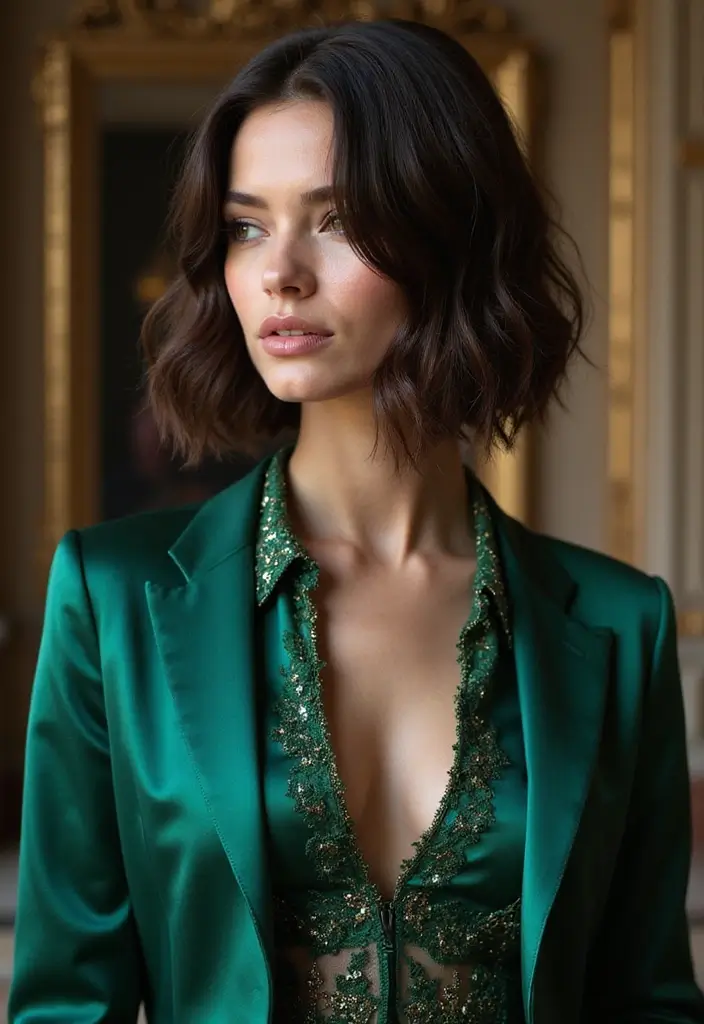
You want a look that feels chic and easy to wear. A glamorous inverted bob gives you a bold shape with soft texture. The back is cut shorter, while the front stays longer. It creates a sharp line that suits many outfits.
– Styling: Curl the ends with a curling iron to make gentle waves. Let the crown stay smooth for contrast. Use a heat protectant before styling.
– Occasions: It shines at parties, date nights, and special events. The waves catch light and draw the eye.
– Maintenance: Book trims every 6 to 8 weeks. Wash with a gentle shampoo and condition the mid-lengths to ends. Lightly restyle to keep the shape.
– Color ideas: Deep chocolate, plum, or rich chestnut add depth. Add subtle highlights near the face to brighten your look.
– At-home steps: Start with clean, dry hair. Section hair and curl away from the face. Use your fingers to loosen the waves. Finish with a light mist to hold.
– Tips for different hair types: If your hair is fine, use a volumizing spray for lift. If you have thick hair, apply a smoothing product to keep the line clean.
– Common questions: Will it suit your face? Oval and square shapes often work best. If you have a round face, keep longer pieces near the cheeks.
Here is why this cut matters: it delivers big style with simple upkeep. Next steps: try a test curl at home and adjust the front length to fit you.
22. Playful Pixie-Inspired Inverted Bob
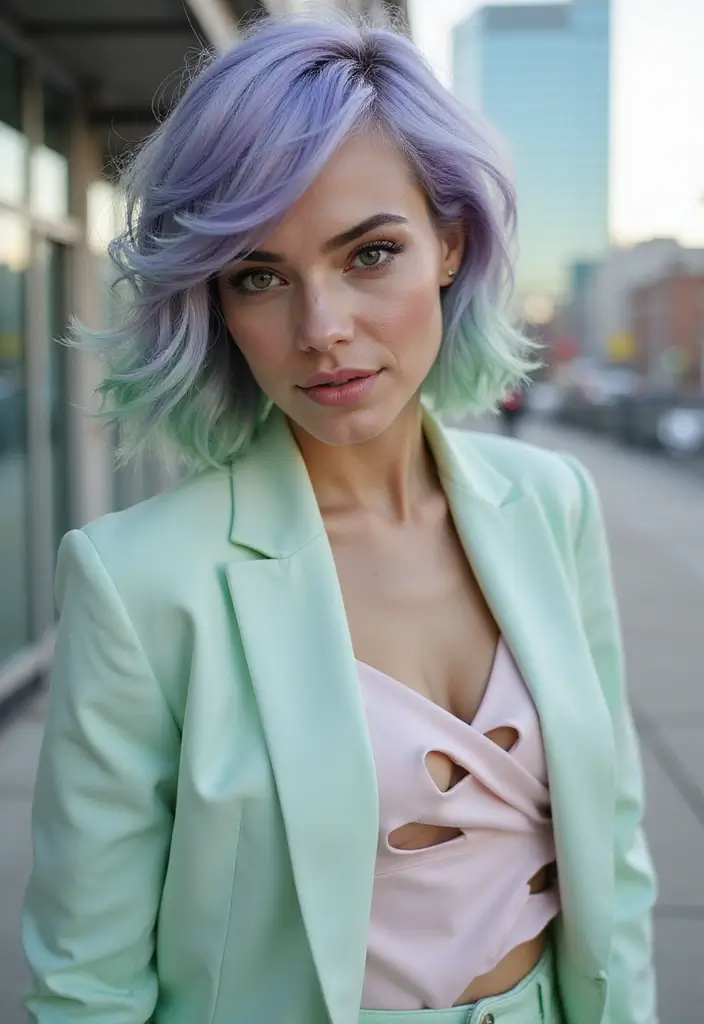
If you want an edge that feels bold but still easy to wear, try a pixie-inspired inverted bob. It uses a shorter back and longer front, giving a sharp shape that suits many face types. The nape stays close to your neck, while the front panels swing a bit longer. The look remains playful and polished at the same time.
Here is why it works. The mix of short and long creates angles that draw attention to your eyes and smile. It moves with you, so you can smooth it for a neat vibe or add texture for a lively feel. You can keep it simple or play with color to change your mood.
– Styling tips: A light pomade or styling cream helps the front pieces pop. Warm a small amount in your hands, then shape the top and front with your fingers. A quick comb through adds a clean finish.
– Occasions: Perfect for casual days, concerts, and creative events. The cut stays comfortable as you move through the day.
– Maintenance: Plan trims every 6 to 8 weeks to keep the line sharp and the shape true.
– Color ideas: Bright shades on the longer front panels catch light. Try neon pink, electric blue, or copper for contrast.
This inverted pixie cut offers a look that is playful yet stylish. If you want a change that stays practical, give it a try.
23. Chic Half-Up Inverted Bob
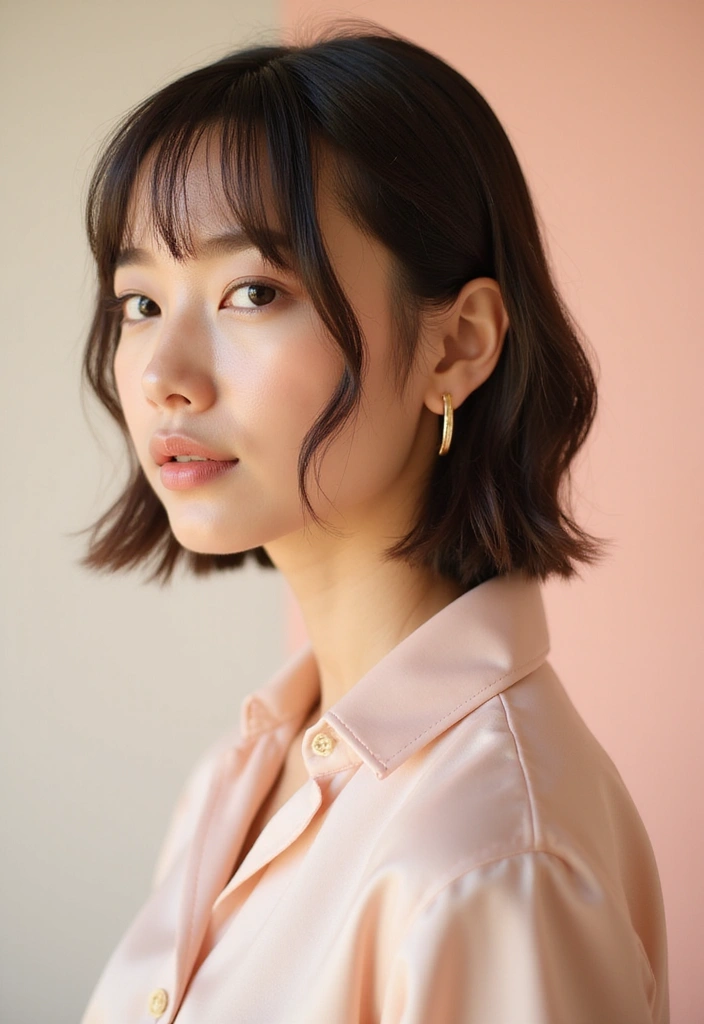
– Chic Half-Up Inverted Bob
If you want hair that stays out of your face but keeps the bold inverted bob shape, this style works. It’s a great fit for fine hair. It gives gentle volume at the crown and shows off the stacked layers at the back. It also feels effortless enough for daily wear.
– How to style it
1) Section a half ponytail from ear to ear on the top of your head. Keep the rest down to reveal the inverted cut.
2) Lightly tease the crown for lift, then smooth the top layer before pinning the section at the back with a small clip or a slim hair tie.
3) Tweak with a touch of shine serum or light hairspray so everything stays in place without stiffness.
4) Pull a few face-framing strands loose for a softer look and to frame your features.
– Occasions
Great for casual days, meetings, or lunch.
– Maintenance and color ideas
Keep it neat with a quick trim every 6 to 8 weeks. For color, a subtle ombre or balayage adds depth without overpowering the cut.
– Why readers love it
The half-up version gives you a modern twist on the inverted bob while keeping the length visible and easy to manage.
Give it a try this week and adjust the height for your face shape.
24. Rainbow Inverted Bob
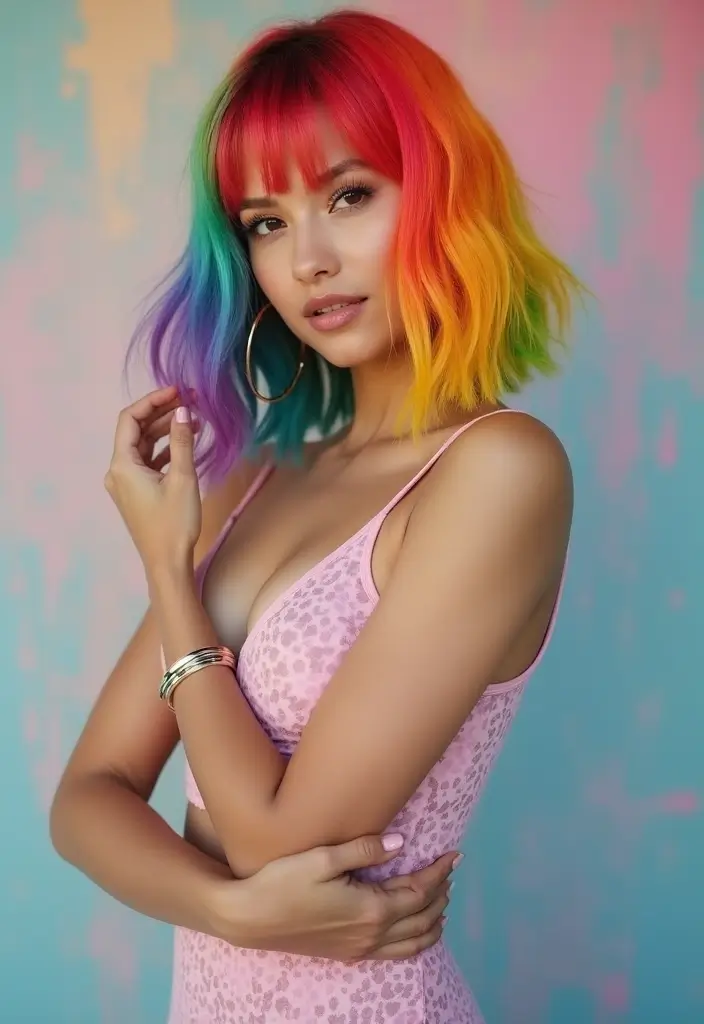
Looking for a bold hair look that stays easy to wear? The rainbow inverted bob can be your answer. It uses a short back and longer front, so color shows from every angle. Colors flow together in a soft rainbow across the length. This cut and color mix grabs attention in a crowd, yet it can feel simple when you want it to.
Here is why you may love it. You get a stylish shape that shows off color without too much fuss.
– Styling Tip: Use temporary hair dye for a fun, non-permanent look.
– Occasions: Great for festivals, parties, or any night out with friends.
– Maintenance: Colors fade with washing. Plan regular touch-ups or use color-safe products.
– Color Ideas: Mix pink, teal, purple, and yellow. Blend two shades for a soft rainbow, or go bold with several hues.
This hairstyle lets you test bright color without a long commitment. You can switch looks with the season or your mood.
Next steps: Decide how vivid you want the rainbow, then talk with a stylist about the base tone and dye plan. Consider starting with a single accent color to see how you like it. Also ask for a small test strand to see how the shades look in daylight.
25. Sophisticated Tucked-In Inverted Bob
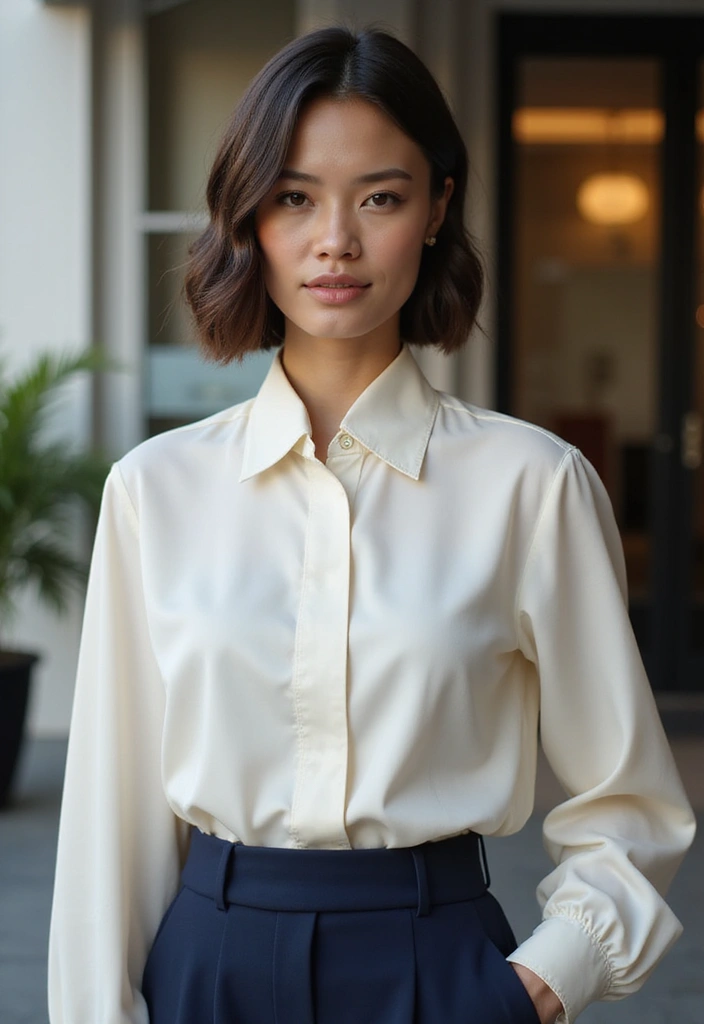
Want a formal look that stays neat from the ceremony to the after party? The Sophisticated Tucked-In Inverted Bob gives you that clean, classy edge. The ends tuck under, forming a smooth line around your jaw. It works especially well for fine hair, adding polish without extra weight or fuss. You can wear it straight for a sharp office look, or pair with soft waves at the crown for balance.
– Styling tip: Apply a smoothing serum to tame flyaways, soften the cuticle, and add a natural shine.
– Occasions: Perfect for weddings, galas, or important office events. It pairs well with a blazer or a soft dress.
– Maintenance: Get trims every 6 to 8 weeks to keep the tucked-in edge crisp and prevent gaps.
– Color ideas: Go with deep hues like dark mahogany or chocolate brown to boost the sleek look.
This look speaks of grace and control.
– How to style at home:
1) Blow-dry with a round brush to push the ends under.
2) Lightly run your fingers along the nape and sides to keep the tucked shape.
3) Finish with a light spray for hold without stiffness.
Next steps: try this look when you want a polished, easy-to-wear cut that still stands out. This keeps you ready for any formal event.
26. Layered Bangs Inverted Bob

Here is why layered bangs with an inverted bob can be your go-to look. You get a fresh vibe that still feels classic. The face-framing bangs brighten your features while the longer layers add movement. Let’s break it down so you can pull it off.
What you gain Layered bangs skim the brow and cheeks, softening sharp angles. The inverted bob keeps the neck clear and adds a playful bounce.
How to style Start with clean, towel-dried hair. Apply a heat protectant. Dry with a round brush, lifting at the crown and guiding the bangs forward to shape the line. Finish with a cool burst to set the style. If needed, smooth the ends with the brush for a clean edge.
Maintenance Regular trims keep the bangs sharp. Plan a trim every 3 to 6 weeks. Check the bob length every 6 to 8 weeks. If your bangs grow fast, trim them at home in small, careful snips.
Color ideas Subtle highlights lift the layers. Try caramel or honey tones for warmth. An ash or beige blonde keeps the look modern and easy to maintain.
Next steps Try a test day with light makeup and a simple outfit. If you like it, book a cut to tailor the length to your face shape.
Layered bangs with an inverted bob not only brighten your features but also add playful movement. Embrace the elegance of this timeless style and let your hair do the talking!
27. Stacked Inverted Bob
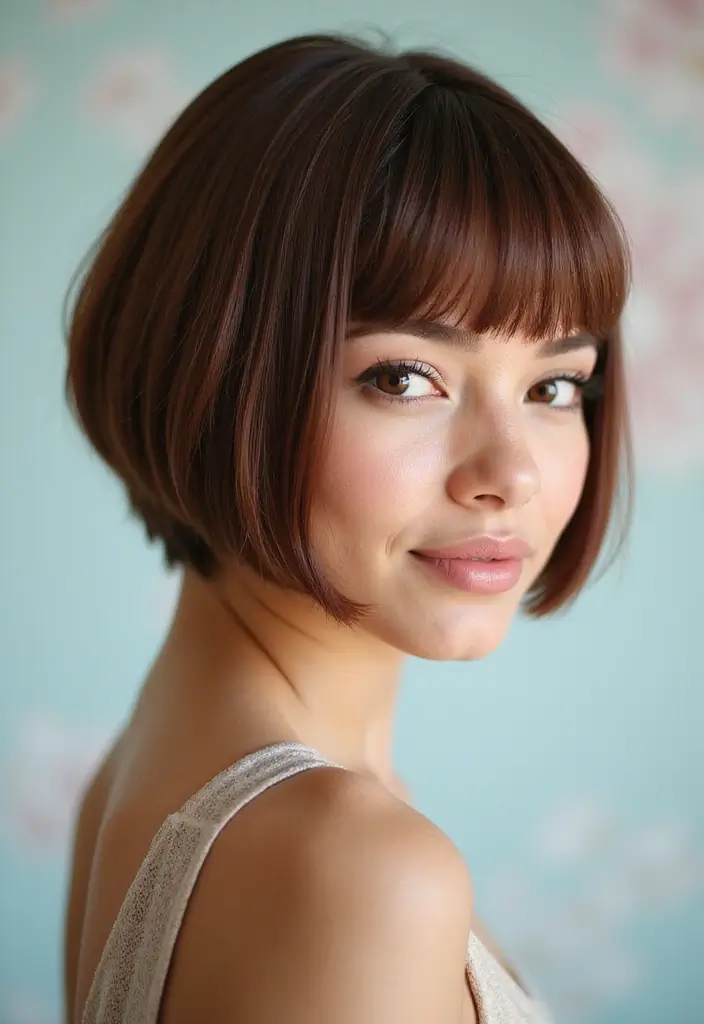
Stacked Inverted Bob might be your best option if you want more lift in fine hair. It uses short layers at the back and longer strands toward the front. That setup adds height at the crown and creates a smooth, curved silhouette. Wear it straight for a clean look, or add soft waves for bounce.
– Styling tip: pinch the roots with a small comb or brush while you dry to push up the crown.
– Occasions: great for daily wear, and it also stands out at parties or meetings.
– Maintenance: plan a trim every 6 to 8 weeks to keep the stacked shape neat.
– Color ideas: a subtle two-tone or soft highlights add depth and make the layers pop.
Here is why it works: the back layers give volume where hair tends to lie flat. The front length frames your face and can be shaped to suit your features. It’s easy to adapt to different textures—part it for a smooth finish or pinch waves for texture.
Let’s break it down further: this cut stays flattering as you move, wash after wash.
Here is why you should try it: it is simple to style and stays polished all day.
Next steps: choose a length that sits just above or at the chin and bring photos to your stylist. Do a quick at-home test curl to preview the wave option. With regular care, it stays fresh and stylish.
Elevate your elegance with a Stacked Inverted Bob! With short layers at the back for lift and longer strands in front for a graceful touch, this style is your go-to for effortless sophistication every day.
28. Quirky Inverted Bob with Accessories
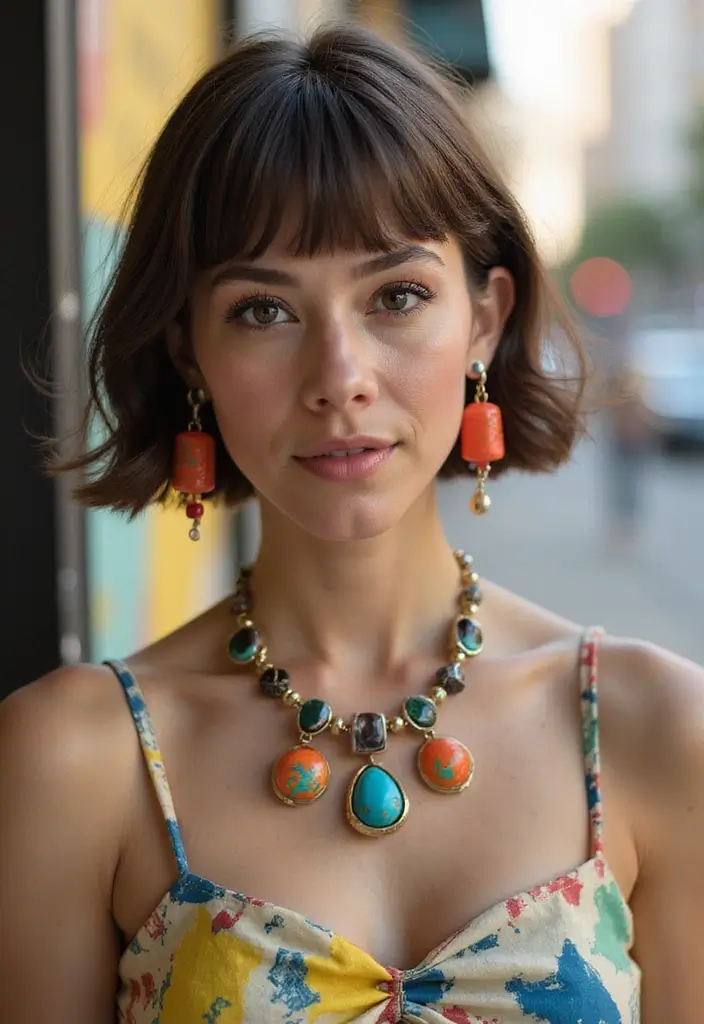
Are you after a playful twist for your inverted bob? The quirky inverted bob with accessories adds personality without a big cut. It keeps the shape you love.
Here is how to do it:
– Pick 2 or 3 pieces that fit your outfit and mood.
– Place accessories at the crown, along the part, or at the ends to change the vibe.
– Secure with small pins or a thin clip so it stays put all day.
– Adjust the position until it feels comfy and balanced.
Accessory ideas to try:
– Hairbands wrap around the crown to create a soft halo.
– Clips at the temples add a quick shine.
– Colorful hair ties add a bold pop.
– Pearl pins give a chic, subtle touch.
Occasions that shine with this look:
– Festivals and events.
– Casual meetups with friends.
– Creative gatherings.
Maintenance and color ideas:
– Maintenance means regular trims to keep the inverted shape clean.
– Color ideas: Match accessory colors to your hair and outfit.
If you stack too many pieces, the look can feel busy. Start with one or two pieces and add more as you go.
Final thought: This style shows your personality without a big change. Keep it balanced for a neat look.
Conclusion
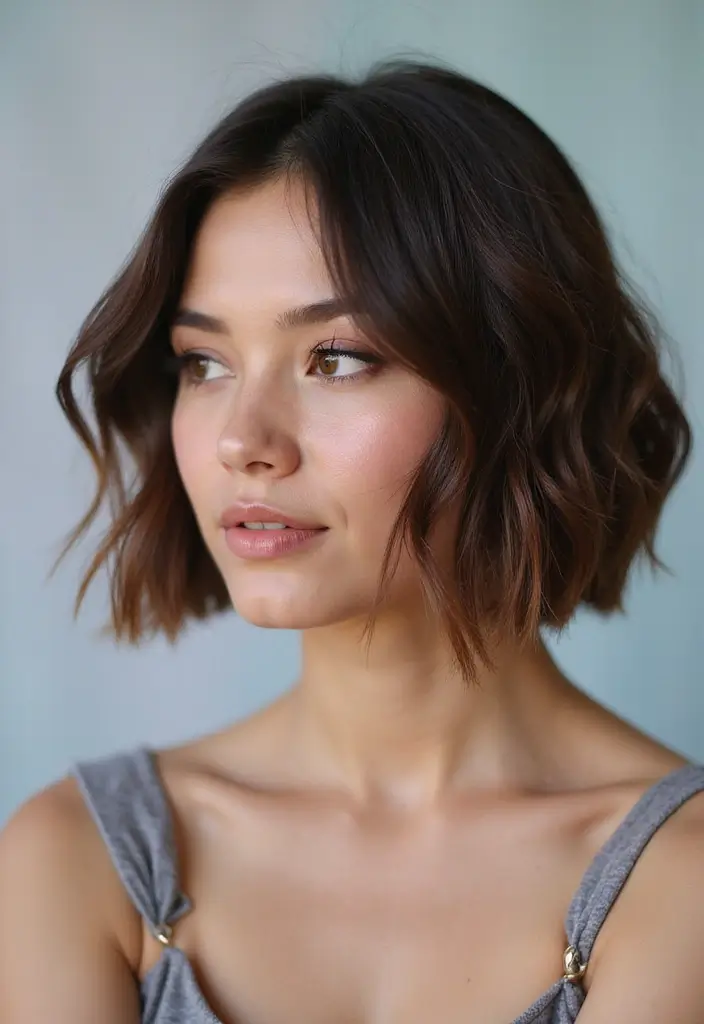
Each of these 28 inverted bob styles offers a unique twist on a classic favorite, emphasizing elegance and creativity. Whether you prefer a sleek and polished look or something a bit edgier, there is a perfect style for everyone. Now is the time to embrace your inner trendsetter and explore these chic options that will undoubtedly turn heads wherever you go.
Frequently Asked Questions
What is an inverted bob haircut and how is it different from a regular bob?
An inverted bob haircut features a shorter back and longer front strands, creating a stylish angle that adds volume and dimension. Unlike a regular bob, which is typically uniform in length, the inverted bob’s unique shape enhances the face and gives a modern flair to your look.
This style is perfect for those looking to add a bit of elegance while keeping it chic and trendy.
Can inverted bob haircuts work for fine hair?
Absolutely! Inverted bob haircuts are a fantastic choice for fine hair. The layers and angles create the illusion of thickness and volume, making it a popular option for those with finer strands. Styles like the layered inverted bob or high-volume inverted bob are especially effective at adding bounce and movement to your hair while maintaining a chic appearance.
So, if you have fine hair, don’t hesitate to rock an inverted bob!
What styling products are best for maintaining an inverted bob haircut?
To keep your inverted bob looking fabulous, consider using a few key styling products. Lightweight volumizing mousse can add body and lift, while a smoothing serum helps control frizz and enhances shine.
For styles with waves or curls, a good texturizing spray or sea salt spray can help achieve that effortless, chic look. Always remember to use heat protectant if you’re using hot tools to style your hair!
Are there any face shapes that suit inverted bob haircuts better than others?
Inverted bob haircuts are quite versatile and can flatter various face shapes! They particularly shine on oval and heart-shaped faces, as the angles help accentuate cheekbones and jawlines.
However, if you have a round face, opting for an asymmetrical or longer front can create a more elongated look. The beauty of the inverted bob is that it can be tailored to enhance your unique features, so don’t shy away from experimenting!
How can I add a trendy twist to my inverted bob hairstyle?
There are plenty of ways to add a trendy twist to your inverted bob! You can incorporate layers for added texture, try a bold color like an ombre or two-tone effect, or even add bangs for a fresh vibe.
Accessorizing with hair clips or headbands can also elevate your look. Additionally, experimenting with different styling techniques, such as adding curls or waves, can keep your inverted bob looking chic and exciting!
Related Topics
inverted bob haircut
asymmetrical bob
layered bob haircut
trendy bob styles
chic bob hairstyles
elegant hairstyles
short hair trends
fine hair cuts
easy maintenance
textured bob
seasonal haircuts
bold hair colors

